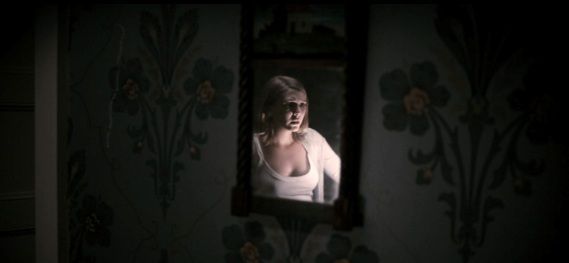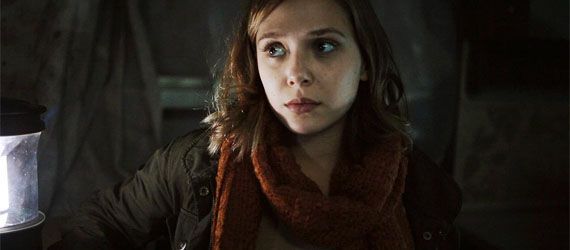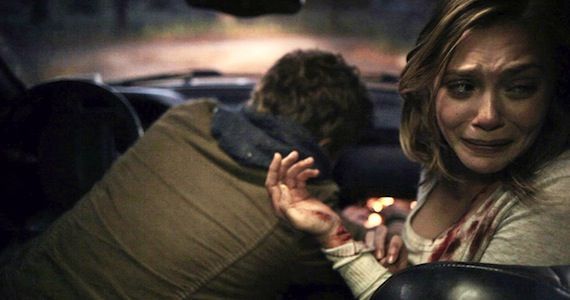In 2003 Chris Kentis and Laura Lau's no-budget, man-against-nature thriller Open Water rocketed to worldwide success. The film had been a passion project for the married couple/creative team, one they spent painstaking years shooting and editing on available weekends. In the time since its initial sale and release they have worked on a variety of projects in the early script and development stages, but this weekend's horror release Silent House represents their first completed film since they dove into the ocean with sharks.
We recently had the opportunity to speak with the co-directors about working with star Elizabeth Olsen, the reasons that the film's ending was altered and how they accomplished Silent House's unique visual style.
A remake of the Uruguayan original (which was based on true events) Silent House follows Sarah (Olsen), her uncle (Eric Sheffer Stevens) and her father (Adam Trese) as they move through and repair their dilapidated and vandalized country house in preparation for putting it on the market. When Sarah begins to hear strange noises she fears that they are not alone and sends her father to investigate - beginning a harrowing ordeal in which she is confronted by all of her deepest terrors.
When the film was originally marketed (following its debut at Sundance) it was hailed as a one-shot movie, an impressive cinematic accomplishment. Indeed the original Uruguayan film was one continuous take, and the American remake is designed to appear as if it is one extended shot, but is in reality, several sequences "stitched" together. As a result, there was a bit of a backlash against the film following the initial PR and marketing blitz.
Chris Kentis addressed those who have criticized Silent House for "faking" the effect:
"You know it is a single shot movie. It’s a movie that as the story unfolds you are experiencing it in a single shot. Now that’s an illusion that we created, but Gollum isn’t real in 'The Lord of the Rings,' but he works great. It isn’t a matter of how we achieved it, it's a matter of the effect of the single-shot and giving audiences this unique experience."
Ultimately, Kentis feels that the visual aesthetic was just a way to tell the story that worked for the tone that they were hoping to achieve. He believes that the technical particulars will be irrelevant once the lights do down.
"I think once an audience sits down to experience a movie, and they lay down their money, they have certain expectations. And if the movie is successful, then they get involved in the story and the characters and go on this ride. They’re not thinking about one-shot, two-shot or anything else because I don’t think they really care. I think what we're trying to do and what we were excited about when we took this project on was a chance to present the story cinematically in a very different way than any other film that I can think of, especially a genre film in this country."
"I think the whole film is really about Sarah’s reality and Sarah’s experience of what’s going on," Lau adds. Keeping the camera diligently trained on their actress in what appeared to be one 88-minute take serves to evoke a feeling of claustrophobic connection with her character.
In order to achieve the illusion Laura Lau wrote the script and then, once they had a location, went back in to tailor it to the house they would be working in. They broke the script down into long but manageable sequences with distinct edit points.
"And Chris and I would start running the whole movie -- literally," Lau recalls. "I would play Sarah’s part and he would be filming and we would work out the choreography."
Once they had a clear idea of what they wanted to do they brought cinematographer Igor Martinovic in. Martinovic worked with the directors for a week in the house, designing the shots and crafting different rigs for the Canon 5D. They then went into a two week rehearsal period. One week off set with the actors and one week in the location working out the technical details with the entire team. The film was shot in just one week.
With such a tremendous focus on the technical aspects of the production Kentis and Lau needed a lead who could be trusted to deliver the emotional intensity that the role required under the rigorous demands of the shoot.
Lau praised the young actress for managing both the technical and emotional requirements for the role:
"I think Lizzy (Olsen) really brings that depth to her character. I think she really has her own process. I shared with her my process in writing the script but I think that Lizzy took what she needed for her own process and she didn’t really need a lot of information to bring what she brought to her performance. I think she understood it."
Other filmmakers would perhaps consider breaking the one-shot illusion at a certain point in the film, in order to highlight particular shifts and moments of significance but, for Kentis, that was never an option.
"We talked about that and we decided that to do that would be falling back and a let down. We created a certain kind of language and when we tried to play with those things it broke that language in a way that was negative and took you away from the character. And suddenly it was a different movie because then things were presented in a much more typical fashion. Again, for the ending of this to work, for the whole movie to work, this is Sarah’s journey and we realized that this is all about discovering as she discovers."
The ending has indeed been a point of contention for some. We will not reveal anything that would spoil the film here but we did speak with the directors about their decision to re-shoot the conclusion of the film - following the Sundance premiere.
Lau explains:
"I think the main reason that the ending changed was that it didn’t communicate what it was that we needed it to communicate. People saw the film and they came up with conclusions that were not what we intended. And so we had an option to go back and clarify that."
Kentis elaborates:
"Another thing that was interesting was that we had never done a remake before and there were certain things that worked in the original that don't necessarily work here. And it was a fine line of wanting to make it your own and having respect for the original film. I think our original ending owed more to what was taking place in the original film. And this new ending is a departure from that."
You can experience the new Silent House ending for yourself beginning today. Take a look at what star Elizabeth Olsen has to say about the film HERE, read our final review HERE, and stay tuned for a post-opening spoiler filled discussion of the film with the filmmakers about a week from now.
Silent House is now playing in theaters.
Follow me on twitter @jrothc



